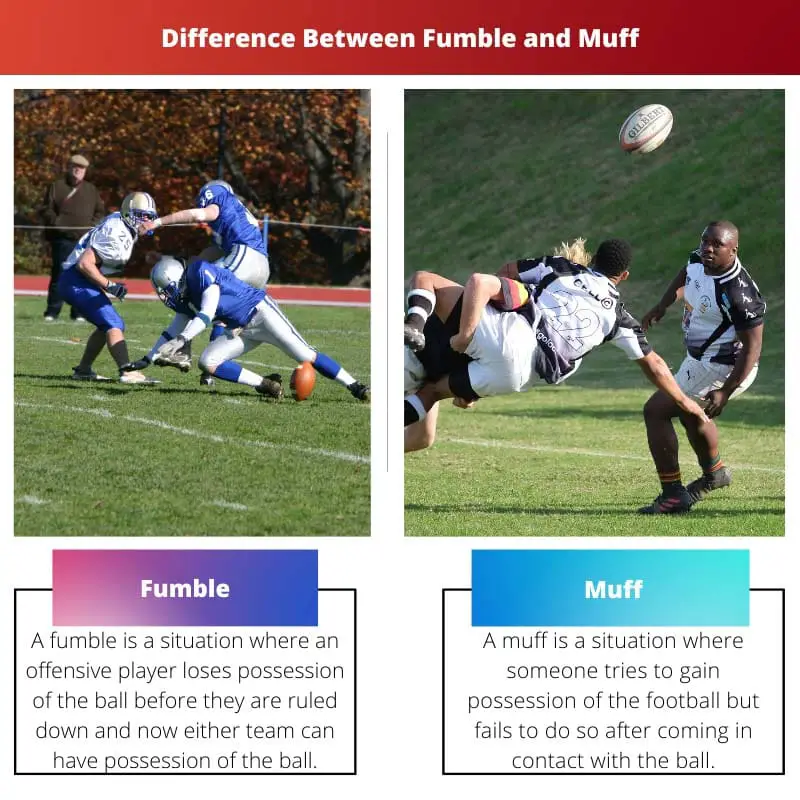Fumble and muff are very confusing terms in football and their differences cannot be understood properly for beginners. There are many situations where a muff can be recorded as a fumble but maybe not the other way around.
Muffs can also be of several types but all types are not very important.
Key Takeaways
- Fumble is an act of mishandling or dropping the ball in sports, while a muff is a similar act of mishandling the ball in sports such as football or rugby.
- Fumble is more commonly used in American football, while muff is used in rugby and Australian rules football.
- Fumble implies an unintentional mistake or error, while muff can be intentional or unintentional.
Fumble vs Muff
In American football, a fumble refers to a situation where a player who is in possession of the ball drops it, loses control of it, or has it stripped away by an opposing player. A muff occurs when a player who is not the ball carrier fails to cleanly catch or secure a kick, such as a punt or kickoff, and the ball hits the ground or is recovered by the opposing team.

A fumble is different from a pass or a kick and is just a situation where the player loses possession of the ball. According to the NFL Rule Book, if a player intentionally fumbles forward then it is considered as a forward pass.
The easy way to recover a fumble is to fall on the ball and cover it entirely.
A muff is a common situation that can be spotted in football. When a player doesn’t have possession of the ball in the first place and then loses the chance to have control of it after touching it is called a muff.
Comparison Table
| Parameters of Comparison | Fumble | Muff |
|---|---|---|
| Definition | A fumble is a situation where an offensive player loses possession of the ball before they are ruled down and now either team can have possession of the ball. | A muff is a situation where someone tries to gain possession of the football but fails to do so after coming in contact with the ball. |
| Muffed Punt | A muffed punt is not a fumble because the ball wasn’t in possession in the first place. | A muffed punt is the most common scenario of muff in football. |
| Kicking Team | If the kicking team recovers the ball, they can advance a fumble. | A kicking team cannot advance a muffed punt. |
| Classification | Fumble doesn’t have any further classifications and it just describes a specific situation. | There are various types of muffs in a football game and they are called by various names. |
| Recording | A fumble is not known to be recorded as a muff in any circumstances. | In many situations, a muff can be recorded as a fumble. |
| Rule | The main rule is any player from either of the team can recover or catch a fumble either before or after the ball strikes the ground. | The main rule of muff is that the defensive team may not advance it but can surely recover it. |
What is Fumble?
The NFL Rule Book states several rules on a fumble, who can catch it, receive it, etc. There are two different rules for a fumble if it goes backward and forward.
For example, if the fumble goes forward and out of the bounds, then the ball will be put in the spot of the fumble by the team that was last in possession of the ball.
Similarly, if the fumble goes backward and out of the bounds, then the ball then the ball is next put in the inbounds spot by the team who last possessed it.
So, apart from the spot the team who last possessed it will always have the upper hand. Though fumbles are very exciting to watch, the probability of an actual occurrence of it is very low.
After the ball is fumbled, the clock stops and it again resumes after the ball is given who last has its possession. There was also confusion between whether an incomplete pass can be constituted as a fumble or not.
But the Tuck Rule made it clear that if a player tucks the ball into his body and then loses possession, it is a fumble. One needs to do a deeper reading to understand the complete difference between a fumble and an incomplete pass.

What is Muff?
Muffs can be better explained with the help of a few examples. The terms like muffed snap or muffed punt are more commonly used than the term muff itself. Muffed snap can be better explained with the help of an example.
Consider a situation where the quarterback doesn’t receive the snap or doesn’t catch the snap-in shotgun, this can be considered as a muffed snap.
It is considered so because the ball was never in the possession of the quarterback in the first place. Now if the offense recovers it is still a muffed snap but if a defensive player recovers it then it is a fumble.
Another situation is when a live ball is on the ground and a player makes an attempt to recover it but comes in contact with it. This situation is also analyzed as a muff.
When a player from either of the team makes an attempt to catch a forward pass but fails, it is also a muff. Sometimes a dropped pass can be confused with a muff as well.
There can be several situations where a player intentionally tries to muff a ball. In this case, it is not considered as a muff but a batted ball. Players intentionally do it sometimes because they want to keep the players of the other team from recovering the fumble.
Main Differences Between Fumble and Muff
- A fumble is a situation where an offensive player loses possession of the ball before they are ruled down whereas a muff is where possession is failed but contact is made with the ball.
- A muffed punt is not a fumble whereas a muffed punt is the most common scenario of the muff.
- If the kicking team recovers the ball, they can advance a fumble whereas they cannot advance a muff.
- A fumble is not further categorized whereas there are many types of the muff.
- A fumble is not known to be recorded as a muff in any circumstances whereas, in many situations, a muff can be recorded as a fumble.

- https://www.jstor.org/stable/43609239
- https://www.tandfonline.com/doi/abs/10.1080/09332480.2019.1695442
